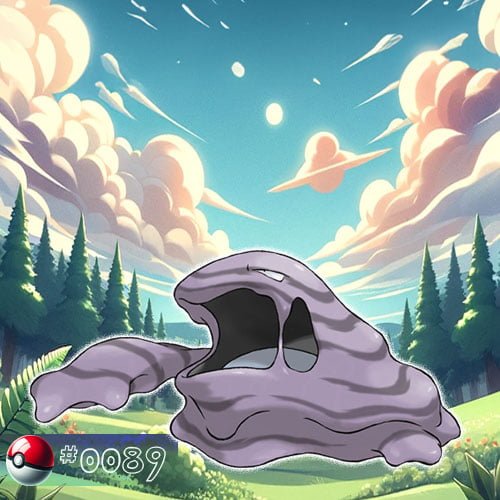Muk
Muk is a Poison-type Pokémon, known for its sludgy and toxic appearance. It is the evolved form of Grimer. This Pokémon has a distinctive, overpowering stench that can be quite offensive.

| National Pokedex No: 0089 |
| Type: |
| Category: Sludge Pokémon |
| Height: 1.2 m (3′11″) |
| Weight : 30.0 kg (66.1 lbs) |
| Gender: 50% ♂, 50% ♀ |
| Abilities/Hidden abilities:
Stench or Sticky Hold/Poison Touch |
Biology
Physical Characteristics
Muk possesses distinctive physical characteristics that set it apart.
Muk’s body is amorphous and lacks a defined shape. It resembles a large, living pile of sludge or goo. he sludge that makes up Muk’s body can have variations in color and consistency, ranging from darker shades of purple to bright pinks. Muk’s sludge is often depicted as having a thick, gooey consistency, giving it a tangible and three-dimensional appearance.
Muk’s eyes are often portrayed with a noticeable glow, adding an eerie and menacing quality to its overall appearance. The glowing eyes contribute to Muk’s imposing and intimidating presence, especially in dimly lit environments.
Within Muk’s sludge, there may be visible impurities, debris, or even partially dissolved objects, emphasizing its nature as a living mass of pollutants. Artists and animators may emphasize the texture of Muk’s sludge, highlighting details like slimy drips, bubbles, or small solid particles suspended within the goo.
Muk’s size can vary based on factors such as its level of health, emotions, or the concentration of toxins within its body. It might expand or contract, showcasing its adaptability and dynamic nature.
The toxic stench emitted by Muk can be visually represented with wavy, noxious fumes or clouds surrounding its body. Illustrations might capture the reactions of other characters to the overwhelming smell, further emphasizing its potency. Some depictions showcase Muk appearing as if it’s melting or oozing, highlighting its fluid and ever-changing form. Muk might reform itself after being split or divided, showcasing its regenerative abilities.
Alolan form
Alolan Muk, a variant of the original Muk found in the Alola region, exhibits distinct physical characteristics that set it apart from its Kantonian counterpart.
Alolan Muk has a different color scheme compared to the regular Muk. It features a vibrant color palette with a combination of bright blue and yellow-green hues. This contrasts with the traditional Muk’s darker, more subdued colors.
Alolan Muk has added features, such as large crystals or rocks embedded in its body. These crystals contribute to its unique appearance and tie in with Alola’s geological and volcanic aspects.

Alolan Muk is often depicted with glowing eyes, adding an eerie and otherworldly aspect to its appearance. This glowing effect may be a result of its interaction with the crystals on its body or an adaptation to Alola’s unique lighting conditions.
Alolan Muk has a somewhat altered shape, with the crystals protruding from its body, giving it a more rugged and jagged appearance. Its overall size and silhouette remain similar to regular Muk. Alolan Muk’s physical adaptations are linked to its environment in the Alola region, which is influenced by volcanic activity and unique geological formations. These adaptations showcase how Pokémon can evolve differently in distinct regions.
Alolan Muk retains the Poison typing of its Kantonian counterpart but gains an additional Dark typing in Alola. This dual Poison/Dark typing contributes to its altered appearance and behavior. The crystals and unique coloration of Alolan Muk are reflective of the geological and environmental influences of the Alola region, showcasing how Pokémon can adapt and evolve based on the specific conditions of their habitat.
These nuanced details contribute to Muk’s visual appeal and make it a fascinating and dynamic Pokémon with a wide range of artistic interpretations across various Pokémon media.
Behaviour
Muk’s behavior is influenced by its Poison-type nature and its unique physiology. Here are detailed aspects of Muk’s behavior.
Muk is known to be fiercely defensive, especially when it feels threatened or cornered. It uses its toxic sludge and powerful moves to fend off attackers. Muk is territorial and may fiercely protect its habitat from intruders. It often claims a specific area as its own and may become aggressive towards those who encroach upon it.
As a Poison-type Pokémon, Muk emits toxic fumes and gases. These emissions serve as a defense mechanism, deterring predators and potential threats with its noxious stench. Muk’s behavior is often associated with pollution and environmental degradation. It may be attracted to areas with high levels of pollution or industrial waste, reflecting its affinity for toxic environments.
Muk is highly adaptable to various environments, including polluted urban areas and industrial zones. Its ability to thrive in these conditions showcases its resilience. Muk’s survival strategies involve using its sludge for camouflage, disguising itself in its environment, and ambushing prey or foes when they least expect it.
While Muk may not have traditional means of communication, it likely uses chemical signals or pheromones to convey information to other members of its species. Muk may display social behaviors within its own species, forming groups or colonies in areas with ample food sources or favorable conditions.
Muk sustains itself by absorbing nutrients from the polluted substances it encounters. It may feed on waste, garbage, or other materials found in its habitat. Muk has the ability to regenerate and reform itself, allowing it to recover from injuries sustained in battle or other encounters.
Trained Muk under the care of a Pokémon Trainer can exhibit loyalty and obedience. However, its inherently defensive nature may still manifest during battles or when it perceives a threat to its Trainer.
Muk’s behavior is intricately linked to its role as a Poison-type Pokémon, with a focus on defense, adaptation to harsh environments, and survival in polluted areas. Its behaviors make it a fascinating and unique species within the Pokémon world.
Evolution
Muk is the evolved form of Grimer. Here are the details of Muk’s evolution.
Muk is part of a two-stage evolutionary line, starting with Grimer and evolving into Muk. The evolution process occurs through normal leveling up, where Grimer gains experience points in battles or through various activities. Upon reaching level 38, Grimer automatically evolves into Muk.
Grimer gains experience points by participating in battles, defeating wild Pokémon, or receiving experience-enhancing items. Accumulating enough experience points leads to level advancement and triggers the evolution.
The evolution from Grimer to Muk involves a visual transformation where Grimer’s form changes into the larger and more complex structure of Muk.
Upon evolution, Muk generally experiences an increase in its base stats, including hit points, attack, defense, special attack, special defense, and speed. The exact stat changes may vary between different Pokémon games. Upon evolution, Muk may also learn new moves or gain access to a broader move pool. These moves can enhance Muk’s battling capabilities and strategic options.
In the Alola region, Grimer evolves into Alolan Muk. The Alolan form has distinct characteristics, including a Dark/Poison typing and a different appearance compared to the regular Muk. In the Alola region, Grimer evolves into Alolan Muk starting at level 38. The evolution process and triggers are similar to the standard Muk evolution. In some Pokémon games, the Alolan Muk evolution may involve an additional trigger, such as exposure to an evolutionary stone like the Poisonium Z or the use of an item specific to the Alolan region.
Muk’s evolution from Grimer represents a significant stage in its life cycle, leading to a more powerful and evolved form with enhanced capabilities for battling and survival. The Alolan variant adds an additional layer of diversity to Muk’s evolutionary possibilities in the Pokémon world.
Appearances
Anime Main Appearances
Ash’s Muk
In the episode “Sparks Fly for Magnemite”, Ash captures a Muk that had disrupted the Gringey City power plant. Quickly transferred to Professor Oak‘s lab, Muk consistently attempts to smother the professor. In “The Fourth Round Rumble”, Ash utilizes Muk in battle against Jeanette Fisher’s Bellsprout, which had previously defeated his Bulbasaur and Pikachu.
Other appearences include:
- “The Legend of Thunder!” (Attila utilized a Muk to thwart Vincent’s Meganium and Jimmy’s Typhlosion from freeing Raikou, but it succumbs to Little Miss.)
- “The Psyduck Stops Here!” (Six Muk cause chaos – three invade Lake Psyduck, relocating to a more suitable home lake.)
- “Secrets From Out of the Fog!” (Team Plasma Grunt’s Muk battles Ash and friends, but Iris’s Excadrill’s Focus Blast prevails.)
- “A Young Royal Flame Ignites!” (The Revengers utilize an Alolan Muk to aid Viren during his Battle Royal, distracting Incineroar.)
- “Healing the Healer!” (Pokémon hunters poison a lake with Muk to attract Suicune. Once caught by Goh, it battles and falls to Ash and Goh.)
- “The Pendant That Starts It All: Part Two” (An Alolan Muk belongs to the Rising Volt Tacklers crew.)
Anime Minor Appearances
Four Muk participated in the Fire and Rescue Grand Prix in “The Fire-ing Squad!”, successfully extinguishing the fire before Ash’s team. In “Carrying On!”, a sick Muk was treated at Way Away Island’s Pokémon Center. Additionally, a flashback in “The Joy of Water Pokémon” depicted a Muk residing in Lake Lucid. An Alolan Muk enjoyed dropped pancakes in “Racing to a Big Event!”, while a Scientist’s Muk competed in the Pokémon Grand Eating Contest in “Crowning the Chow Crusher!”.
A Trainer’s Muk appeared also in the following epsodes:
- ”An Old Family Blend!” (participated in the Lily of the Valley Conference)
- ”Alola, Kanto!”
- ”This Magik Moment!” (participated in the Alola Pokémon Quiz)
- ”This Could be the Start of Something Big!”
Manga Appearances
Ash & Pikachu
A Muk owned by Ash just appeared on the scoreboard in ”One Half Of A Poké Ball”.
The Electric Tale of Pikachu
Off-screen, Ash captures a Muk, utilizing it during the Indigo League. Muk triumphs in a battle against Jeanette Fisher’s Bellsprout.
Pokémon Adventures
In its debut in this manga, “You know… Articuno!” Muk aids Harry and Team Rocket in their Articuno mission. Later, it faces Red’s Gyara but gets frozen by Articuno.
Owned by Koga in “Karate Machop!”, Muk battles the Elite Four on Cerise Island, aiding Koga’s survival as the island crumbles. It participates in the Pokéathlon during the HeartGold & SoulSilver arc.
In “Pinsir Me, I Must Be Dreaming,” a Muk appears in a fantasy, while in “Innocent Scientist,” it is seen in a flashback as part of the Pokémon trained by the International Police. Team Plasma Grunts own multiple Muk in “Angry Boy” and “Abyssal Ruins”.
Moon’s Alolan Grimer evolves into Muk in “Darkness!! The Mysterious Claws of Necrozma!”.
Pokémon Pocket Monsters
Giovanni utilizes multiple Muk to disrupt the TV contest in “Seize the Dream of One Million Yen!!”. Another Muk joins the celebration in “Pikachu’s Birthday Party”. Koga’s Muk is revealed during Red’s battle against Karen.
Game data
Stats
Location
| Game version | Location |
|---|---|
| Pokémon Red and Pokémon Blue | Pokémon Mansion |
| Pokémon Yellow | Power Plant, Pokémon Mansion, Cinnabar Island |
| Pokémon Gold and Pokémon Silver | Routes 16, 17, and 18, Celadon City |
| Pokémon Crystal | Routes 16, 17, and 18, Celadon City |
| Pokémon Ruby and Pokémon Sapphire | Evolve Grimer |
| Pokémon FireRed | Evolve Grimer |
| Pokémon LeafGreen | Pokémon Mansion |
| Pokémon Emerald | Evolve Grimer |
| Pokémon Colosseum | Trade |
| Pokémon XD | Evolve Grimer |
| Pokémon Diamond and Pokémon Pearl | Evolve Grimer |
| Pokémon Platinum | Evolve Grimer |
| Pokémon HeartGold and Pokémon SoulSilver | Routes 16, 17 and 18, Celadon City, Safari Zone |
| Pokémon Black and Pokémon White | Trade |
| Pokémon Black 2 and Pokémon White 2 | Castelia Sewers, Route 9 |
| Pokémon X and Pokémon Y | Friend Safari |
| Pokémon Omega Ruby and Pokémon Alpha Sapphire | Evolve Grimer |
| Pokémon Sun and Pokémon Moon | Evolve Grimer (Alolan Form) |
| Pokémon Bank (Kantonian Form) | Trainers' School, Hau'oli City, Malie City (Alolan Form) |
| Pokémon Ultra Sun and Pokémon Ultra Moon | Evolve Grimer (Alolan Form) |
| Pokémon Bank (Kantonian Form) | Pokémon Mansion, Power Plant (Kantonian Form) |
| Pokémon: Let's Go, Pikachu! | Pokémon Mansion, Power Plant (Kantonian Form) |
| Evolve Grimer (Alolan Form) | Trade |
| Pokémon: Let's Go, Eevee! | Trade |
| Pokémon Sword and Pokémon Shield | Unobtainable |
| Pokémon Brilliant Diamond and Pokémon Shining Pearl | Evolve Grimer |
| Legends Arceus | Unobtainable |
| Pokémon Scarlet and Pokémon Violet | Tera Raid Battles (Kantonian Form) |
| Trade (Alolan Form) |
Muk's origin name
Muk’s name is generally kept consistent across languages, with slight variations in pronunciation and characters based on linguistic differences.
English: Muk – The English name “Muk” is derived from the word “muck,” which refers to a slimy, dirty substance. This name reflects the Pokémon’s Poison-type attributes, as it is often associated with toxic sludge and pollution.
Japanese: ベトベトン (Betobeton) – The Japanese name “Betobeton” is a combination of the Japanese words ベトベト (betobeto), meaning sticky or slimy, and ン (n), a common suffix in Pokémon names.
French: Grotadmorv – The French name “Grotadmorv” is a combination of the words “grotte,” meaning cave, and “admorv,” which is a play on the French word “admirable.” This name emphasizes the Pokémon’s association with polluted environments.
German: Sleimok – The German name “Sleimok” is a combination of “Schleim,” meaning slime, and “Mok,” derived from “Mogel,” which means cheat or deceive. This emphasizes the deceptive and slimy nature of Muk.
Spanish: Muk – The Spanish name “Muk” remains consistent with the English name, directly adopting it without significant alteration.
Italian: Muk – The Italian name “Muk” is consistent with the English name, preserving the association with muck and sludge.
Korean: 질퍽이 (Jilpogi) – The Korean name “Jilpogi” refers to something sticky or gooey, aligning with Muk’s slimy appearance.
Chinese (Simplified): 臭臭泥 (Chòuchòuní) – The Chinese name “臭臭泥” (Chòuchòuní) can be translated to “Stinky Mud,” emphasizing the foul odor associated with Muk’s toxic nature.
Chinese (Traditional): 臭臭泥 (Chòuchòuní) – The Traditional Chinese name “臭臭泥” (Chòuchòuní) can be translated to “Stinky Mud,” emphasizing the foul odor associated with Muk’s toxic nature.
These names not only serve as identifiers for the Pokémon in different regions but also often incorporate elements that highlight Muk’s slimy, toxic, and polluted characteristics.



